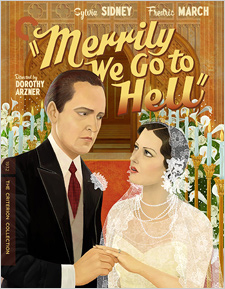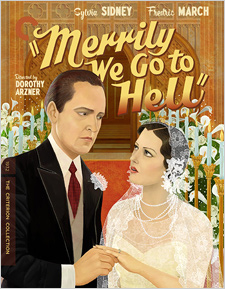Merrily We Go to Hell (Blu-ray Review)

Director
Dorothy AznerRelease Date(s)
1932 (May 11, 2021)Studio(s)
Paramount Pictures (Criterion – Spine #1076)- Film/Program Grade: C+
- Video Grade: A
- Audio Grade: B
- Extras Grade: B+
Review
Dorothy Arzner was the only female director regularly working in Hollywood during her 21-year career. She directed 16 films featuring such stars as Clara Bow, Esther Ralston, Katharine Hepburn, Rosalind Russell, Joan Crawford, Paul Lukas, and Robert Young. Arzner’s films are notable for their depiction of women’s relationships, a reversal of society’s expectations, and female sexuality. Arzner’s Merrily We Go to Hell, centered on marital infidelity and strife, was made in the pre-code period before strict enforcement of the Production Code put a stop to such adult themes.
Adapted from the novel I, Jerry, Take Thee, Jane by Cleo Lucas, Merrily We Go to Hell finds handsome drunk Jerry Corbett (Fredric March) and lovely society girl Joan Prentice (Sylvia Sidney) meeting on a penthouse terrace during a party. Jerry is a failed playwright turned reporter and Joan is the daughter of a wealthy industrialist. As they chat, they make a connection and recognize they are soulmates. But Jerry is also drawn to his ex, Claire Hempstead (Adrianne Allen), and to booze.
Joan mentions that she’d been reading about Jerry, suggesting she knows something about his past. Jerry wants to love Joan unconditionally but is haunted by his failure as a playwright and his failed marriage. His self-image is at rock bottom. Joan’s father (George Irving) is against the marriage but, wanting his daughter to be happy, puts aside his reservations. Circumstances bring Jerry and Claire together and Jerry stops coming home with any predictability. Still in love with Jerry, Joan announces that they will have a modern marriage—he can continue carrying on with Claire and she will have boyfriends, all out in the open.
This premise would not be possible a year later when Hollywood’s self-censorship amped up for fear that the government would step in. Tame by today’s standards, the film was pretty strong stuff in the early 1930s.
March overdoes his drunken Jerry in the opening scene yet manages to convey charm rather than elicit disdain. It’s the waning of Prohibition and liquor flows for everyone, not just Jerry. Although Joan’s love puts all of Jerry’s weaknesses secondary, viewers are unlikely to see Jerry with lovestruck eyes. He’s more a selfish, parasitic cad than a loyal husband and lover.
Sidney’s Joan looks and behaves like a demure debutante, which makes her desperate embrace of an ostensibly unorthodox view of marriage something of a shock. She loves Jerry so much, she’s willing to share him if that’s what it will take to hold onto him. This is both admirable, in that she is a woman well before her time, and sad, as she is destined for disappointment. The script portrays her as intelligent, self-assured, and forthright. She is not driven by flowery images of wedded bliss but by her understanding that marriage is an arrangement that is subject to conditions. We never really see any emotional change in Joan. Sidney plays her on a single note throughout, making her appear more of a noble victim of modern mores than a human being.
A brief scene about halfway in features Cary Grant as Joan’s date at a party. He delivers his few lines of dialogue with distinctive charm and is as handsome and dashing as always. Unfortunately he’s gone in a couple of minutes.
Arzner introduces considerable melodrama as the story unfolds. She has March ham it up a bit too much and doesn’t elicit enough feeling from Sidney. The script, despite its then-taboo nature, never fully engages the viewer. The “meet cute” scene on the terrace is supposed to convince us that Jerry and Joan are made for each other, but it’s a bit too fast to ring true. And since the film relies on this connection, it seems inauthentic. Though only 83 minutes long, the film manages to deal with substance abuse, female sexual liberation, and an alternate view of marriage long before such ideas were widely discussed. Despite the film’s controversial subject matter, the ending is conveniently pat and predictable.
Featuring 1080p resolution, Merrily We Go to Hell is presented on Blu-ray by The Criterion Collection in the aspect ratio of 1.37:1 with a new digital transfer created in 4K resolution from a 35 mm composite duplicate negative. According to the booklet, “thousands of instances of dirt, debris, scratches, splices, and warps were manually removed.” Digital Vision’s Phoenix was used for jitter, flicker, small dirt, grain, and noise management. The picture looks great for a film close to 90 years old. Blacks are deep and velvety and shades of grey are nicely balanced. Sylvia Sidney’s gowns have shiny, glittery accents which make them stand out. The penthouse terrace at the beginning of the film is the most impressive looking set. Shot in a studio, it features a skyline backdrop with lights shining through distant windows.
The soundtrack is English Mono LPCM with optional English subtitles. The dialogue is clear and distinct throughout. Dialogue dominates, with ambient sound subordinated. The one exception is the penthouse terrace scene. There is a slight though noticeable echo, since the scene is shot in the studio.
Bonus materials include a 1983 documentary on the life and career of director Dorothy Arzner, a new video essay, and a booklet featuring a critical article about the film and its impact.
Dorothy Arzner: Longing for Women – In 1980, filmmaker Katja Raganelli and her husband, cinematographer Konrad Wickler, traveled from Munich to California to make a documentary about Arzner. She had recently died in a car accident, but Raganelli visited her desert home and retraced her life and career through her personal photographs and interviews with actor Esther Ralston. Views of Arzner’s house and gardens are shown along with stills and behind-the-scenes production photos. Arzner’s early childhood is discussed and her later desire to become an ambulance driver in Europe during World War I. As a director “she was working in a team group with other temperaments.” When she was about to leave Paramount to direct elsewhere, Paramount studio head B.P. Schulberg tossed her a script to direct and told her to be ready in three weeks. That film was Fashions for Women, and the reviews were encouraging. Esther Ralston, star of that film, discusses the plot and refers to Arzner as “brilliant,” very serious with not much of a sense of humor but “way beyond her years in ability.” The documentary is presented in German and English, with English subtitles.
Video Essay – In this 27-minute video essay, film historian Cari Beauchamp notes that almost half the films made before 1929 were written by women. Dorothy Arzner was the only female director working regularly in Hollywood in the 1930s and 1940s. She watched Cecil B. DeMille direct and, impressed with his in-charge demeanor, was determined to one day direct films. She was also impressed by the massive set for Intolerance, directed by D.W. Griffith. Arzner drove ambulances during the flu epidemic of 1918. She was influenced by many women to enter the young moviemaking industry. She worked as script girl and editor in silent features until given the chance to direct her first feature in 1927. That film, Fashions for Women, became the number one Paramount release for several weeks. She met choreographer Marion Morgan, who would become her life partner. “She was an innovator and practical to the core.” She made Paramount’s first talkie, The Wild Party, starring Clara Bow, in 1929. On this film, she had many problems with early microphones and sound booths. A fishing pole with a microphone attached to the end was used to follow actors and get a clear recording. This was the genesis of the boom mic. Merrily We Go to Hell was the tenth film Arzner directed at Paramount and the fourth with Fredric March. It was released a year before Prohibition ended and a year and a half before the Production Code was enforced. Though earlier films had suggested a man or woman straying from their marriages, this one spelled out infidelity directly, helping to bring on the strict enforcement of the Production Code. Career overviews are provided for Fredric March and Sylvia Sidney.
Booklet – An enclosed 4-page insert booklet includes a critical essay by Judith Mayne, a list of cast and key crew, artwork of Fredric March and Sylvia Sidney, and information about the film’s digital transfer.
Merrily We Go to Hell is an interesting cinematic artifact, made at a time when content was more open and adult. When enforcement of the Production Code went into effect in 1934, writers were constrained by Hollywood’s self-imposed censorship. This would last well into the late 1960s, when the Motion Picture Association of America introduced the film ratings system.
- Dennis Seuling

